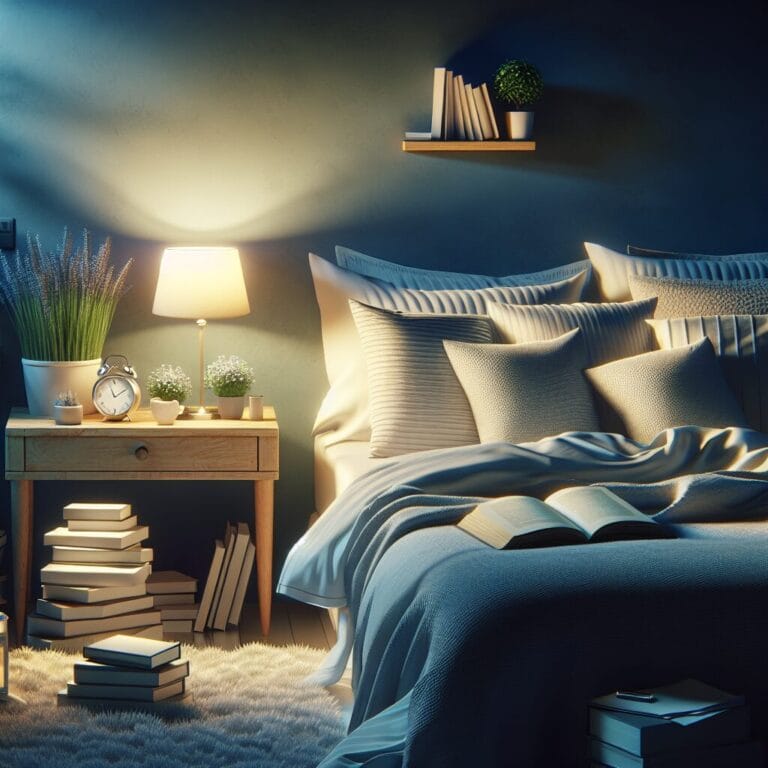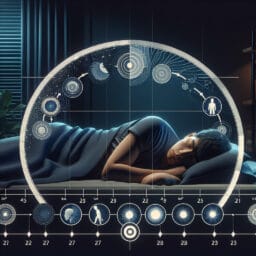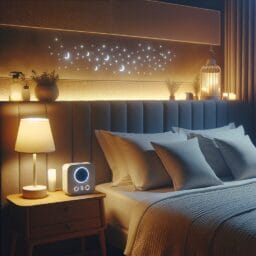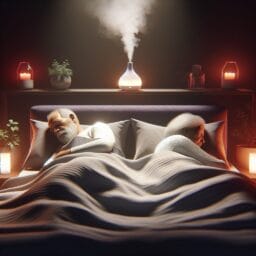
5 Sleep Optimization Tips for Middle-Aged Adults Embracing a Tech-Driven Lifestyle
Table of Contents
- Introduction
- Embracing a Consistent Sleep Schedule
- Creating a Tech-Free Bedroom Sanctuary
- Mindful Use of Technology Before Bedtime
- Incorporating Relaxation Techniques into Evening Routines
- Diet and Exercise Considerations for Better Sleep
- Conclusion
- Frequently Asked Questions
Introduction
Hey there, sleep seekers! Did you know tweaking your tech habits can lead to zzz’s that’ll have you waking up feeling like a superhero? Yeah, that’s right – with some simple tech tweaks, we can all be on our way to dreamland without counting a bazillion sheep.
First off, let’s chat about those fancy gadgets and gizmos we’re glued to before bedtime. You’ve probably heard they’re not the BFFs of sleepy time, and that’s because they emit bright light. This sneaky light makes our brains think it’s still daytime – not cool when trying to catch some winks! So, how about we make our bedrooms technology-free zones? Imagine your room being the comfiest cave for snoozing; no beeps and buzzes, just pure bliss.
Now onto something called circadian rhythm – it’s like an internal clock inside us that loves routines. It tells us when it’s time to wake up or hit the hay. Keeping steady sleep and wake times even on weekends can work wonders for this natural cycle and help avoid sleep problems like insomnia or sleep apnea.
For older adults or anyone who finds themselves tossing and turning, monitoring body temperature could be key. Our core body temperature needs to drop a smidge for deep sleep mode to activate. Fancy thermostats or cooling mattress pads are tech-savvy solutions worth considering!
And how about embracing wearable tech that tracks your zzz’s? These smart devices gauge how much shut-eye you’re getting in different sleep stages (like REM and deep sleep). With this intel, you can make changes for better night rests.
Lastly, let’s think beyond gadgets – lifestyle factors play a massive role too! Finding ways to soothe back pain, reducing stress for mental health (maybe through meditation apps), and keeping active for an immune system boost will all lead you closer to quality sleep.
So folks, let’s dive into these tips for good nights’ sleep because waking up refreshed is nothing short of magical. And remember: upgrading your slumber with a little help from technology is as easy as pie—sweet dreams pie! 🌜✨
Embracing a Consistent Sleep Schedule
Are you ready to transform your night-time routine into a launchpad for stellar slumbers? It’s all about the rhythm – the sleep rhythm, that is! Just like your favorite toe-tapping tune, your body craves consistency. So, what’s the secret sauce to outstanding sleep quality? Drumroll, please… establishing and sticking to a regular sleep pattern!
Here’s the lowdown: our bodies have this amazing thing called a circadian rhythm, which is a fancy way of saying we have an internal clock that thrives on predictability. Hitting the hay and waking up at consistent times each day isn’t just good practice; it’s science-backed strategy to combat poor sleep. And guess what? Older adults can seriously benefit from this too, as they are more prone to sleep disturbances.
So, how do you lock down that sweet spot for hitting the sheets and rising with the sun? Start by picking a bedtime and wake-up time that allows for enough Zs. Experts recommend 7-9 hours of shut-eye to fend off the dreaded sleep deprivation blues. Once you’ve chosen those golden hours, stick to them like glue – yes, even on weekends or when jet lag tries to sneak in!
But life happens – we get it! Holidays roll around or maybe a late-night movie beckons. In these cases, use tech tweaks smartly: set reminders for winding down and employ apps that gently nudge you toward sleep-friendly activities (think calming sounds or bedtime stories). And don’t forget about managing light exposure; dimming electronic devices well before bedtime helps keep your circadian rhythm humming along without missing a beat.
Maintaining a technology-free bedroom supports uninterrupted rest too. By creating an environment where gadgets take a back seat, you pave the way for good sleep hygiene practices that can prevent sleep loss and improve overall mental health.
Remembering these steps might seem daunting at first but fret not – it’s like riding a bike through dreamland once you get going. You’ll soon find yourself zipping along the path towards quality sleep without so much as bump in the night. Ready to embark on this journey towards blissful bedtimes? All aboard the snooze cruise! 🚢💤
Creating a Tech-Free Bedroom Sanctuary
Let’s switch gears and talk about something that might shock you: the blue light beaming from our beloved screens has a pesky habit of telling our brains to stay wide awake! That’s right, folks – whether it’s your smartphone or your snazzy flat-screen TV, those devices can seriously mess with your sleep quality by fiddling with your circadian rhythm. This means even if you hit the hay at a reasonable hour, that sneaky blue light could lead to poor sleep and leave older adults especially at an increased risk for sleep disorders like insomnia.
So, what’s the game plan? First up, start dimming those electronic devices as bedtime approaches. Most gadgets these days come equipped with night modes or settings that reduce blue light exposure in the evening hours. By making this simple tech tweak, you’re sending a signal to your body that it’s time to wind down.
But wait – there’s more! To really amp up your sleep health, consider turning your bedroom into a technology-free sanctuary. Imagine a cozy cave where calm reigns supreme; no pings or pop-up notifications allowed! This move isn’t just smart; it’s key in crafting the perfect bedroom environment for deep sleep.
And when it comes to alternatives to screen time, have you ever tried audio relaxation? There are apps aplenty offering soothing sounds ranging from gentle raindrops to whispering winds. Or dive into the world of audiobooks and let captivating stories lull you into dreamland. These nifty swaps not only improve sleep quality but also help maintain good nights’ sleep consistently.
Remember, older adults aren’t the only ones who can benefit from these tips – we’re all aboard this snooze train together! So give these strategies a whirl and watch as they pave the way towards better rest and stronger mental health without falling victim to the negative effects of too much tech before bedtime. A well-rested tomorrow awaits after embracing these healthy habits today!

Mindful Use of Technology Before Bedtime
In the hustle and bustle of our high-tech lives, it’s easy to overlook how our beloved gadgets might be ninja-stealing precious shut-eye from us. Picture this: it’s late at night, and you’re scrolling through your feed when bam! Your brain gets zapped by a bright light cocktail, making it tougher to drift off into dreamland. But fear not, sleep warriors! The digital world isn’t all about sleep sabotage; it comes bearing gifts in the form of apps and tools designed to shield us from that sneaky blue light.
Now let’s talk tactics for tackling those tempting screens before bedtime. It’s like training for an Olympic sport – but instead of aiming for gold, we’re gunning for gold-star sleep hygiene. Let’s dive into the app arena where night mode features reign supreme. These handy helpers dial down the blue light and bathe your screen in warm colors as evening falls, whispering to your brain that it’s time to power down.
But wait—there’s even more tech magic at your fingertips! Have you met the apps dedicated solely to prepping you for snooze o’clock? They swap bright light with dimmer switches or red-tinted overlays that tell your body “Hey buddy, sleepy time is near.” And they aren’t just good for adults; older folks can also swing back into a groovy sleep rhythm with these smart solutions.
Besides cozying up with tech tweaks, laying down some ground rules can be a game-changer. Designate a ‘no-device zone’ starting one hour before bed. Yes, this means parting ways with phones, tablets, and laptops—all guests must check out of Club Bedroom before the party (aka quality sleep) starts!
We can’t ignore other lifestyle factors either; they’re key players on Team Good Night’s Sleep. Ensuring your bedroom temperature is just right plays nice with your core body temperature for deep sleep wins. Add a dash of relaxation routines like stretching or reading (a real book!) and you’re setting the stage for an epic night’s slumber.
Conquering the sleep-loss epidemic might sound like climbing Mount Everest in slippers, but by arming ourselves with these tech tips and tricks while dialing back on electronic devices come twilight time, we switch from counting endless sheep to embracing sweet dreams faster than you can say “good night!” So go forth and harness technology as your bedtime ally; after all, modern problems require modern solutions!
Incorporating Relaxation Techniques into Evening Routines
Did you know that a relaxed mind can lead to dreamier nights? Yep, the secret ingredient for stellar sleep might just be a dollop of relaxation. Now, before you think it’s all about deep massages and fancy spa days, let me loop you in on some surprisingly simple ways to dial down stress and welcome quality sleep into your life.
Picture this: It’s evening time, and instead of being attached to buzzing gadgets, you’re swathed in serene sounds from a white noise machine. These soothing symphonies work like a charm for older adults (and really anyone else) by masking disruptive noises that could lead to poor sleep. Trading bright light from screens for the calming glow of a salt lamp or sunset simulator can also nudge your circadian rhythm toward sleepyville.
But wait—there’s more! Deep breathing exercises are like a remote control for your nervous system; with each inhale and exhale, you can turn the volume down on stress. Or maybe give progressive muscle relaxation a whirl by tensing and then melting away tension from head to toe—it’s like giving yourself permission to release the day’s troubles onto your comfy mattress.
Let’s not forget about aromatherapy. A whiff of lavender or chamomile isn’t just pleasant for your sniffer; these scents have been buddies with good sleep since forever, especially helpful when combating jet lag or anxiety before bedtime. Spritz some on your pillow or add a few drops to your bedside diffuser, and let nature’s perfumes pave your way into deep sleep.
Integrating these chill-out tactics into your nightly routine doesn’t require flipping your world upside-down either. Start small—a book here (the paper kind), some gentle stretches there—and soon enough, these moments of calm become second nature.
So here’s a nugget of wisdom: Tuning out from technology and tuning into tranquility doesn’t only improve sleep quality but enriches life overall. By creating an oasis free from electronic devices coupled with practices that soothe body temperature and mind alike, we don’t just fight the sleep-loss epidemic—we thrive in our quest for restful nights! Now go forth, fellow dream catchers; may tonight’s slumber be as peaceful as a floating feather. 🍃💤
| Technique | Description | Benefits |
|---|---|---|
| White Noise Machine | Emits a consistent, soothing sound to mask disruptive ambient noises. | Improves sleep by creating a relaxing sound environment. |
| Lighting Adjustment | Use a salt lamp or sunset simulator to provide calming glow that preps your body for sleep. | Helps regulate circadian rhythm and promotes relaxation. |
| Deep Breathing Exercises | Controlled breathing to help reduce stress and relax the nervous system. | Decreases stress levels and prepares the body for sleep. |
| Progressive Muscle Relaxation | Tense and release each muscle group, starting from the head down to the toes. | Releases muscle tension and promotes physical relaxation. |
| Aromatherapy | Use scents like lavender or chamomile to create a peaceful atmosphere. | May reduce anxiety and improve sleep quality, especially when combating jet lag. |
| Reading Physical Books | Engage in reading paper-based books as part of your evening routine. | Encourages relaxation by reducing screen time and engaging the mind in a calming activity. |
| Gentle Stretches | Performing light stretching exercises to relax the muscles and calm the mind. | Helps relieve physical tension and can improve sleep quality. |
Diet and Exercise Considerations for Better Sleep
If you’re on a quest to conquer the sleep-loss epidemic and snag that elusive good night’s sleep, then it’s time to talk turkey about chow time and its bedtime buddy, exercise. Bet you didn’t know that what’s on your dinner plate can waltz right into your dreams! Chowing down on foods rich in tryptophan – like turkey and bananas – or magnesium – think spinach or almonds – can really jazz up your journey to the land of nod. These nutrients are the bees-knees because they have a knack for calming nerves and muscles, setting you up for quality sleep.
And let’s not forget our pal caffeine; while it may seem like a daytime hero, come evening, it shifts into a villainous role if consumed too late. That innocent-looking cup of joe post-dinner might just be the ringleader behind those pesky poor sleep patterns. So steer clear of caffeinated culprits at least six hours before hitting the hay to ensure they don’t mess with your circadian rhythm.
Now onto physical fitness – did you know that breaking a sweat during the day is like sending a VIP invite to Mr. Sandman? Regular exercise boosts all sorts of bodily functions, including helping older adults fight off sleep disorders like insomnia and sleep apnea. But timing is key! Rocking a workout too close to bedtime could leave your core body temperature too jazzed up for deep sleep. Aim for finishing any heart-pumping activity at least three hours before bed so your body temp has time to cool down and whisper sweet somethings to your sleepy brain.
As for when to eat dinner? Timing meals is an art form when prepping for slumber-time success. Early dinners allow digestion to play out so you’re not lying awake feeling as stuffed as a Thanksgiving turkey. The goal here is simple: enjoy your last meal 2-3 hours before snooze-o’clock so everything from blood sugar levels to digestive engines are nice and steady as you tuck in.
So there we go! A little peek-a-boo into how tweaking munchie moments and keeping active can raise the bar on improving sleep quality without needing tech tweaks or fancy gadgets. Simply by paying attention to lifestyle factors like diet, hydration, and boogie-down daytime activities, we pave the golden path towards dreamland deluxe! 💤🌙
Conclusion
Hey, have you ever wondered if snoozing could be a superpower? With the right tech tweaks and lifestyle switches, improving sleep quality isn’t just a dream—it’s doable! Let’s dive into some fresh insights to boost those Zs. For starters, let’s consider how our environment plays a starring role in the quest for quality sleep. Swapping out bright bedroom lights for dimmer, warmer options can set the scene for deep sleep. And what about those chilly toes? A heated blanket with an automatic shut-off can keep you cozy without overheating as you slumber.
Now imagine this: a gadget that controls all your devices so they power down when it’s time for you to power down too. Smart home tech can help maintain that circadian rhythm by dimming the lights and killing the noise right on schedule. And while we’re talking schedules, older adults could get an extra helping hand from apps that remind them when it’s time to start winding down, making poor sleep less likely.
But hang on—there’s more than tech at play here. Did you know that even the socks you choose to wear at night might influence your body temperature and thus your sleep stages? Yep, it’s true! Also, sniffing around lavender or chamomile scents after dusk may lead to sweeter dreams and fend off any sneaky sleep disturbances lurking around.
So folks, why not become a ninja in the art of snooze-fu? Mix n’ match these tips like a pro: maybe a little less screen time here, a sprinkle of exercise there (but not too late!), and voila! You’ve got yourself a recipe for defeating the sleep-loss epidemic—one peaceful night at a time.
As technology continues to whirl around us day and night, finding balance is key—embracing helpful gadgets while also saying “night-night” to screens can truly spruce up your slumber game. So give these strategies a go; mix ’em up until your bedtime routine feels just right. Here’s to capturing good nights’ sleep in this fast-paced digital world—may every twilight twinkle with promises of rejuvenating rest! 🌟💤




